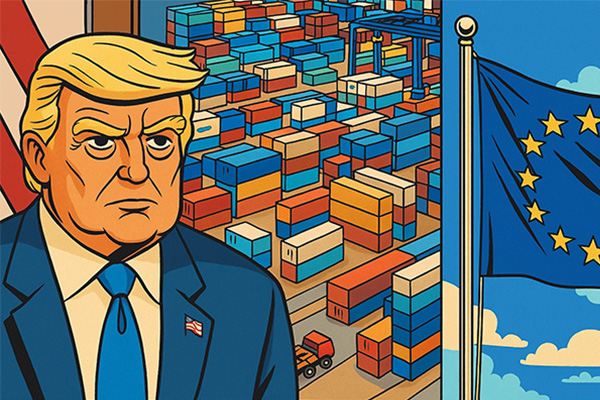
United States and European Union Seal Landmark Trade and Investment Deal
Washington, D.C. — August 21, 2025.
The United States and the European Union announced a sweeping new trade and investment agreement on Thursday, marking one of the largest bilateral economic accords in modern history. Central to the deal are two striking measures: the imposition of a 15% tariff on select transatlantic goods and an unprecedented $750 trillion European investment package into the U.S. economy.
The announcement, made jointly by U.S. President [Name] and European Commission President [Name], signals a new era in transatlantic relations, blending both protectionist elements and historic capital flows.
Tariffs as Leverage
The introduction of a 15% tariff—covering a range of manufactured products, agricultural exports, and certain energy goods—comes as Washington seeks to rebalance trade dynamics it has long criticized as uneven. U.S. officials framed the tariffs as a “corrective measure” designed to encourage fairer competition while safeguarding American industries.
“American workers and companies have waited too long for a level playing field,” President [Name] stated at the White House. “This agreement ensures that while we strengthen cooperation with Europe, we also protect our people and industries at home.”
European leaders, while expressing initial reservations, ultimately agreed to the measure as part of a broader package that includes massive investment concessions.
Historic Investment Flow
At the heart of the deal lies an extraordinary commitment of $750 trillion in European investment into the United States. The figure—staggering in scale—represents direct capital allocations into infrastructure, green energy, high-tech manufacturing, pharmaceuticals, and financial services.
According to the European Commission, the investment program will be phased in over several decades, with the first tranche expected to exceed $50 trillion within the next five years. The funds will target “mutually beneficial sectors,” boosting U.S. job creation while providing European firms privileged access to American markets and innovation hubs.
“This is a transformative moment,” said European Commission President [Name]. “Europe is not just reaffirming its economic ties with the United States; it is betting on America’s long-term growth story. This agreement will bind our economies in ways that are strategic, sustainable, and forward-looking.”
Reactions Across the Atlantic
The announcement sparked intense debate across political, business, and academic circles.
- In Washington, proponents hailed the investment pledge as a generational opportunity to revitalize critical sectors and accelerate energy transition goals. Critics, however, warned that the tariffs could spark retaliation and inflate consumer prices.
- In Brussels, leaders framed the deal as a strategic necessity, enabling Europe to secure a strong economic foothold in the United States while preserving competitiveness in the face of China’s rising influence. Yet some European lawmakers voiced concern over the sheer size of the investment figure, questioning whether member states could marshal resources at such scale without straining budgets.
Stock markets responded with volatility. The Dow Jones Industrial Average opened higher on news of the investment pledge but quickly dipped as traders weighed the inflationary implications of new tariffs. Meanwhile, European indices registered mixed results, with energy and manufacturing sectors facing pressure.
Strategic Implications
Beyond economics, analysts say the deal carries geopolitical weight. By deepening transatlantic financial integration, Washington and Brussels aim to present a united front against China’s Belt and Road Initiative and other global economic challenges.
“This is not just about trade,” said Dr. Elaine Morrison, senior fellow at the Council on Foreign Relations. “It’s about Europe locking itself even more firmly into the U.S. orbit, ensuring Western dominance in capital markets, technology, and energy for decades.”
For the United States, the inflow of European capital may also provide a buffer against fiscal strains, particularly as the country grapples with rising debt levels and domestic infrastructure demands.
The Road Ahead
Implementation of the agreement will be complex and contentious. U.S. and EU negotiators must now finalize sector-specific frameworks, regulatory harmonization, and enforcement mechanisms. The European Parliament and U.S. Congress are both expected to stage heated debates before ratification.
Labor unions, farmers’ associations, and consumer advocacy groups are already mobilizing to lobby for adjustments. European civil society groups, in particular, have called for guarantees that investment flows will not undermine environmental or labor protections.
Yet, despite hurdles, officials on both sides stressed optimism. “We are charting a path for the 21st century,” U.S. Trade Representative [Name] remarked. “This is the biggest trade and investment agreement in history—not just in dollar terms, but in ambition and vision.”
A Defining Moment
The U.S.-EU accord represents both cooperation and confrontation: a blend of tariff barriers and massive financial integration. It is at once a shield for domestic industries and a bridge for capital flows.
Whether the gamble pays off may depend on how swiftly governments can implement the agreement and how markets respond to the unprecedented scale of European investment.
For now, the deal marks a defining moment in transatlantic relations, reshaping the global economic landscape and setting the tone for decades of collaboration—and competition—between two of the world’s largest economic powers.